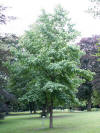WILD
FOODIES' HOME PAGE
PLANT PROFILE LIST
NAME: Sweetgum
LATIN NAME / FAMILY: Liquidambar styraciflua / Hamamelidaceae
OTHER COMMON NAME(S): American Sweetgum
CONDITIONS:
sun-partial shade
|
PARTS: |
EDIBLE |
TASTE |
RAW/COOK |
SEASON |
|
All |
|
|
|
|
|
Shoots |
|
|
|
|
|
Leaves |
||||
|
Stalk/Stem |
|
|
|
|
|
Buds |
||||
|
Flowers |
|
|
|
|
|
Fruits |
|
|
|
|
|
Pods |
|
|||
|
Seeds |
|
|
|
|
|
Nuts |
|
|
|
|
|
Roots |
|
|
|
|
|
Bark |
|
|
|
|
|
Sap / Resin |
|
slightly bitter |
RAW/COOK |
early/Spring |
PORTION: small
COMMENT: Sap/Resin edible. A chewing gum and a stabilizer for cakes etc is obtained from the resin. It can also be chewed to sweeten the breath.(1) Slashed to the cambium, sap will leak out and harden. The resulting gum can be chewed.(2) Foraging Texas says that seeds and raw leaf buds are also edible, (4) but not PFAF or EatTheWeeds.com. The Sweet Gum is distinguished by its "picky balls" and star shaped leaves.
CAUTION:
NUTRITION/MEDICINAL: Antiseptic; Astringent; Carminative; Diuretic;
Expectorant; Parasiticide; Poultice; Salve; Sedative; Stimulant;
Vulnerary.(1) Nutritional Value: seeds contain calories and protein. Other uses:
leaves can be mashed into a poultice for antibiotic and sting-bite relief.(4)
From:
https://www.ncbi.nlm.nih.gov/pmc/articles/PMC4441155/
Sweetgum trees are large, deciduous trees found in Asia and
North America. Sweetgum trees are important resources for medicinal and other
beneficial compounds. Many of the medicinal properties of sweetgum are derived
from the resinous sap that exudes when the outer bark of the tree has been
damaged. The sap, known as storax, has been used for centuries to treat common
ailments such as skin problems, coughs, and ulcers. More recently, storax has
proven to be a strong antimicrobial agent even against multidrug resistant
bacteria such as methicillin-resistant Staphylococcus
aureus.
In addition to the sap, the leaves, bark, and seeds of sweetgum also possess
beneficial compounds such as shikimic acid, a precursor to the production of
oseltamivir phosphate, the active ingredient in Tamiflu®–an antiviral drug
effective against several influenza viruses. Other extracts derived from
sweetgum trees have shown potential as antioxidants, anti-inflammatory agents,
and chemopreventive agents.
LOOK-A-LIKES:
POISONOUS LOOK-A-LIKES:
OTHER USES: Adhesive; Gum; Incense; Parasiticide; Resin; Teeth; Wood. The aromatic resin 'Storax' is obtained from the trunk of this tree. It forms in cavities of the bark and also exudes naturally. It is harvested in autumn. Production can be stimulated by beating the trunk in the spring. The resin has a wide range of uses including medicinal, incense, perfumery, soap and as an adhesive. It is also chewed and used as a tooth cleaner. Wood - heavy, fairly hard, fine-grained, not strong, light, tough, resilient. Takes a high polish and can be stained then used as a cherry, mahogany or walnut substitute. It is also used for furniture, flooring, fruit dishes, veneer etc.
SOURCE LINKS (may include nutritional and medicinal info, plus other uses):
- https://pfaf.org/user/Plant.aspx?LatinName=Liquidambar+styraciflua
- http://www.eattheweeds.com/sweet-gum-tree
- https://en.wikipedia.org/wiki/Liquidambar_styraciflua
- http://www.foragingtexas.com/2008/08/sweetgum.html (good photos)
- https://commons.wikimedia.org/wiki/Liquidambar_styraciflua (good photos)
- https://www.ncbi.nlm.nih.gov/pmc/articles/PMC4441155/



